Search the Blog
Categories
- Books & Reading
- Broadband Buzz
- Census
- Education & Training
- General
- Grants
- Information Resources
- Library Management
- Nebraska Center for the Book
- Nebraska Memories
- Now hiring @ your library
- Preservation
- Pretty Sweet Tech
- Programming
- Public Library Boards of Trustees
- Public Relations
- Talking Book & Braille Service (TBBS)
- Technology
- Uncategorized
- What's Up Doc / Govdocs
- Youth Services
Archives
Subscribe
Author Archives: Sam Shaw
The Data Dude – Wednesday Watch – Rectify
 Recently, one of the Dude’s colleagues here at the Commission conveyed a quote from Oscar Aviles, the warden for the Hudson County, NJ jail. Warden Aviles used to believe that his job was limited to keeping the jail safe; regarding rehabilitation and re-entry programs for inmates, he said: “That’s not my problem. This is somebody else’s problem.” He no longer thinks this way. In other institutions, the end of this line of thinking is long overdue. The Dude thinks libraries have the potential to play a large and important role in that (and are often underutilized by administrators).
Recently, one of the Dude’s colleagues here at the Commission conveyed a quote from Oscar Aviles, the warden for the Hudson County, NJ jail. Warden Aviles used to believe that his job was limited to keeping the jail safe; regarding rehabilitation and re-entry programs for inmates, he said: “That’s not my problem. This is somebody else’s problem.” He no longer thinks this way. In other institutions, the end of this line of thinking is long overdue. The Dude thinks libraries have the potential to play a large and important role in that (and are often underutilized by administrators).
Those of you who know the Dude are aware that he used to work in a correctional facility library. During the time there, the Dude had an inmate who worked with him for almost the entire 9 years. This particular guy told the Dude about an original series show on Sundance TV (owned by AMC Networks) called Rectify. Now, don’t get this confused with Justify. The sound alike, but are two entirely different animals. Justify is a show on FX starring Timothy Olyphant (who also played Sheriff Seth Bullock in the fantastic HBO series Deadwood). In Justify, Olyphant plays Raylan Givens, a no-nonsense U.S. Marshall who returns to his hometown in Kentucky. It’s a sound series, but today’s column is about Rectify. Anyway, this particular inmate told the Dude that by far Rectify absolutely nails the feeling that a person has when they are released from prison. The story of Rectify begins with the main character, Daniel Holden (played by Aden Young) being released from Georgia’s death row after 19 years. He went to death row at the age of 18 for the rape and murder of his 16 year old girlfriend. He confessed to the crime, but there is a lot of doubt about whether or not the confession was coerced. DNA evidence frees him from death row, but it doesn’t necessarily exonerate him. Many in the local community still believe he is guilty, and as the viewer, we really don’t know (at least after two seasons). The first six episodes cover the first six days after his release from prison. Flashbacks tell part of the story of the days during his incarceration. The main thing about Rectify, the thing that the inmate who worked with me in the library wanted to convey, is that it appropriately captures some of the experiences and struggles of prison life, and also the huge challenges of transition back into society (especially after being locked up for 19 years). The subplot (although as the series develops it becomes more and more relevant) is finding out what actually happened on the night of the murder, and the depth of the involvement of the main character, Daniel Holden. But that really is a subplot, at least in the first two seasons.
You might look at the summary of Rectify and believe it’s just another ho-hum cliché of whodunnit, but it is really much more than that. Both season 1 and season 2 are available on DVD. Season 3 is scheduled to begin on July 9, 2015. Since the Dude has no cable, he will need to wait for the DVD or the Netflix streams to get caught up with season 3. According to Firstsearch, no Nebraska libraries (that’s zero, nada) have Rectify on DVD. A number of libraries in neighboring states have it, however, and 289 libraries worldwide. Shaka.
Posted in General, Library Management, Uncategorized
Leave a comment
The Data Dude – The Power of the -1
 As some of you know, the Dude is working to clear up some of the questions that the Census folks have regarding our submitted public library survey data. You may have received a phone call or e-mail with questions about your survey. If you don’t care about the process, skip to the second paragraph below. If you do, read on. As a matter of explanation, IMLS (the Institute of Museum and Library Services) is the agency that oversees the public library survey. The U.S. Census Bureau is the agency that works for IMLS to collect the data. Individual libraries in Nebraska submit their survey data online via Bibliostat (there are other methods, but we use Bibliostat), between the middle of November and the middle of February. Bibliostat has edit checks built into the program to flag certain questions (e.g. if there was a large change from last year), and in order to pass the edit check you need to explain the differences in a note. Once your surveys are submitted, they are reviewed and you might be contacted by the Dude if there are additional questions. Once that is cleared up and all of the surveys are submitted, finalized, and locked, Bibliostat sends us the files of the compiled data and we submit them to Census. When the data goes to Census, there are additional edit checks (both critical and non-critical) that we must pass in order to submit the data. Once that occurs, Census looks over everything and then sends us another file with follow up questions. Generally, this is because there are inconsistencies in the notes that explain the inconsistencies in the data.
As some of you know, the Dude is working to clear up some of the questions that the Census folks have regarding our submitted public library survey data. You may have received a phone call or e-mail with questions about your survey. If you don’t care about the process, skip to the second paragraph below. If you do, read on. As a matter of explanation, IMLS (the Institute of Museum and Library Services) is the agency that oversees the public library survey. The U.S. Census Bureau is the agency that works for IMLS to collect the data. Individual libraries in Nebraska submit their survey data online via Bibliostat (there are other methods, but we use Bibliostat), between the middle of November and the middle of February. Bibliostat has edit checks built into the program to flag certain questions (e.g. if there was a large change from last year), and in order to pass the edit check you need to explain the differences in a note. Once your surveys are submitted, they are reviewed and you might be contacted by the Dude if there are additional questions. Once that is cleared up and all of the surveys are submitted, finalized, and locked, Bibliostat sends us the files of the compiled data and we submit them to Census. When the data goes to Census, there are additional edit checks (both critical and non-critical) that we must pass in order to submit the data. Once that occurs, Census looks over everything and then sends us another file with follow up questions. Generally, this is because there are inconsistencies in the notes that explain the inconsistencies in the data.
UPDATE: Throughout this process, you should be reminded of the codes that Bibliostat and Census use for data that is reported. Now, these codes are -3 (not applicable), -1 (not collected), and just plain ol’ 0. The Dude had previously reported using these codes in your surveys, but was recently told by Bibliostat that they prefer either N/A or 0. They then convert those entries to either -1’s or -3’s for the federal elements. The Dude does ask that for these you include a note indication “not collected” if the question is relevant but you just didn’t collect the data. Shaka.
The Data Dude – Integrated Library Systems
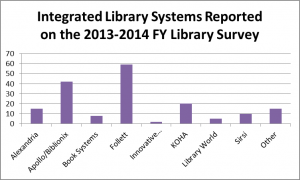 Today, the Dude regurgitates some statistics from last year’s survey (2013-2014) regarding integrated library systems. The leaders (see the chart at the right) are Follett, Apollo (Biblionix), and KOHA (Pioneer Consortium). It should be noted that library needs are different and while one ILS may work real well for one community, it may not be the best choice for another, even when other factors are similar. If you are interested in looking at the data about the ILS your peer libraries are using, you can download the excel file with all the data. Shaka.
Today, the Dude regurgitates some statistics from last year’s survey (2013-2014) regarding integrated library systems. The leaders (see the chart at the right) are Follett, Apollo (Biblionix), and KOHA (Pioneer Consortium). It should be noted that library needs are different and while one ILS may work real well for one community, it may not be the best choice for another, even when other factors are similar. If you are interested in looking at the data about the ILS your peer libraries are using, you can download the excel file with all the data. Shaka.
The Data Dude – Wednesday Watch: Memorial Day Edition
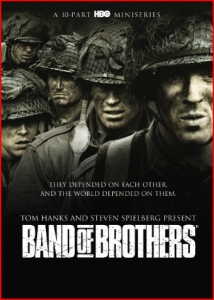 For a Memorial Day edition of Wednesday Watch, let’s talk about Band of Brothers and The Pacific. There are 10 episodes in each of these miniseries offerings from HBO. In order to get the full WWII picture, I think it is necessary to watch both, but I would suggest Band of Brothers first and The Pacific second. Doing so, however, sets the bar high for The Pacific, as Band of Brothers is generally regarded as the better series of the two. Band of Brothers focuses on the WWII European theater, and The Pacific focuses (voila) on the WWII Pacific theater and covers more of the emotional after effects of war in general. I’d argue that The Pacific has a bit more significance because typically the events that occurred there are less known, less written about, and less visualized. The Dude believes that the European theater is more popular for two reasons: (1) since the majority of U.S. citizens migrated from Europe, the countries there are more relatable (consider your knowledge of England and France v.s. the Palau islands (including Peleliu)); and (2) the Hitler effect. As The Pacific illustrates, the fact that the non-European aspects of WWII are less frequently covered in movies and literature doesn’t make them any less dramatic. It should be noted that while both Band of Brothers and The Pacific jibe with most of the actual events, there is some degree of editorial license taken by the producers. These aren’t documentaries, and frankly if you get wrapped up in those minor changes, you miss most of the overall point (hint: it doesn’t really matter). I would suggest that if you are looking for a documentary instead or in addition, watch the fantastic British series World at War. It’s over 22 hours in length, but if you choose to watch an episode per night or week, it is well worth your time.
For a Memorial Day edition of Wednesday Watch, let’s talk about Band of Brothers and The Pacific. There are 10 episodes in each of these miniseries offerings from HBO. In order to get the full WWII picture, I think it is necessary to watch both, but I would suggest Band of Brothers first and The Pacific second. Doing so, however, sets the bar high for The Pacific, as Band of Brothers is generally regarded as the better series of the two. Band of Brothers focuses on the WWII European theater, and The Pacific focuses (voila) on the WWII Pacific theater and covers more of the emotional after effects of war in general. I’d argue that The Pacific has a bit more significance because typically the events that occurred there are less known, less written about, and less visualized. The Dude believes that the European theater is more popular for two reasons: (1) since the majority of U.S. citizens migrated from Europe, the countries there are more relatable (consider your knowledge of England and France v.s. the Palau islands (including Peleliu)); and (2) the Hitler effect. As The Pacific illustrates, the fact that the non-European aspects of WWII are less frequently covered in movies and literature doesn’t make them any less dramatic. It should be noted that while both Band of Brothers and The Pacific jibe with most of the actual events, there is some degree of editorial license taken by the producers. These aren’t documentaries, and frankly if you get wrapped up in those minor changes, you miss most of the overall point (hint: it doesn’t really matter). I would suggest that if you are looking for a documentary instead or in addition, watch the fantastic British series World at War. It’s over 22 hours in length, but if you choose to watch an episode per night or week, it is well worth your time.
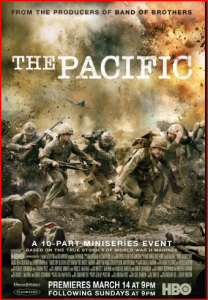 Back to Band of Brothers and The Pacific. I want to make two points. Number one is that for a high school aged kid, I think these should be must watches for the history class. Replacing most (if not all) high school curriculum on WWII with watching these episodes (and perhaps parts of the aforementioned World at War) followed by discussions would make the learning of the events not only more interesting to the students, but give them a more accurate portrayal of the what people went through during this time (on all sides). This is especially true as we are losing many WWII veterans due to age. Also, Band of Brothers in particular teaches more lessons about leadership than any course, book, seminar, or other teaching mechanism that I have experienced. The main example of this is Major Richard “Dick” Winters, portrayed brilliantly by the English actor Damian Lewis. And you wouldn’t realize that he is English because he nails the American accent in Band of Brothers and another stellar series, Showtime’s Homeland. Watch the video. He starts the segment in his non-native accent (American).
Back to Band of Brothers and The Pacific. I want to make two points. Number one is that for a high school aged kid, I think these should be must watches for the history class. Replacing most (if not all) high school curriculum on WWII with watching these episodes (and perhaps parts of the aforementioned World at War) followed by discussions would make the learning of the events not only more interesting to the students, but give them a more accurate portrayal of the what people went through during this time (on all sides). This is especially true as we are losing many WWII veterans due to age. Also, Band of Brothers in particular teaches more lessons about leadership than any course, book, seminar, or other teaching mechanism that I have experienced. The main example of this is Major Richard “Dick” Winters, portrayed brilliantly by the English actor Damian Lewis. And you wouldn’t realize that he is English because he nails the American accent in Band of Brothers and another stellar series, Showtime’s Homeland. Watch the video. He starts the segment in his non-native accent (American).
Posted in General, Library Management, Uncategorized
Leave a comment
The Data Dude – Public Libraries and Hispanics
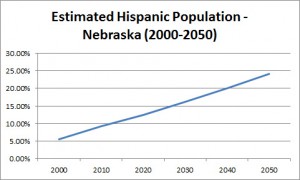 Shaka. Pew Internet research recently released a report about Public Libraries and Hispanics. If you have a large or increasing Spanish speaking constituency that your library serves, perhaps you might want a closer in-depth look at the Pew report. The report is important because the Hispanic population in Nebraska has grown, and is projected to continue to rise (see the chart at the right—sources: U.S. Census and UNO Center for Public Affairs Research). The increasing Latino/Latina population underscores the need for Spanish language materials (more than half of immigrant Hispanics are Spanish-dominant speakers). Interestingly, immigrant Latinos also are more likely to prefer audio and video over print book reading (32% v.s. 18% of whites). Also, Latinos are more likely to view library closings as having a major impact on their families and communities (40% v.s. 26% for whites). How many libraries have collection development policies specifically addressing materials in languages other than English? I’d venture to say a number have a version of these already. Perhaps it is time to review those, and plan for the future.
Shaka. Pew Internet research recently released a report about Public Libraries and Hispanics. If you have a large or increasing Spanish speaking constituency that your library serves, perhaps you might want a closer in-depth look at the Pew report. The report is important because the Hispanic population in Nebraska has grown, and is projected to continue to rise (see the chart at the right—sources: U.S. Census and UNO Center for Public Affairs Research). The increasing Latino/Latina population underscores the need for Spanish language materials (more than half of immigrant Hispanics are Spanish-dominant speakers). Interestingly, immigrant Latinos also are more likely to prefer audio and video over print book reading (32% v.s. 18% of whites). Also, Latinos are more likely to view library closings as having a major impact on their families and communities (40% v.s. 26% for whites). How many libraries have collection development policies specifically addressing materials in languages other than English? I’d venture to say a number have a version of these already. Perhaps it is time to review those, and plan for the future.
The Data Dude on Smartphone Use
 This week, the Dude takes a look at a recent Pew Internet report on smartphone use. First, let’s first not assume everyone knows what is generally meant when referring to a smartphone. A smartphone (or smart phone, if you prefer), is a device that functions as a phone (you can call or send text messages to other dudes) but also has additional capabilities. For example, it allows a person to browse the web, take photos and video with its camera, GPS navigation, and run a whole host of additional apps and games, either online or offline. Smartphones have various sized touchscreens. While these devices provide the user with the capability to get online with Wi-Fi (if available), most also allow mobile web use if you pay for a plan that has it (such as 4G) when you aren’t near a place that has Wi-Fi.
This week, the Dude takes a look at a recent Pew Internet report on smartphone use. First, let’s first not assume everyone knows what is generally meant when referring to a smartphone. A smartphone (or smart phone, if you prefer), is a device that functions as a phone (you can call or send text messages to other dudes) but also has additional capabilities. For example, it allows a person to browse the web, take photos and video with its camera, GPS navigation, and run a whole host of additional apps and games, either online or offline. Smartphones have various sized touchscreens. While these devices provide the user with the capability to get online with Wi-Fi (if available), most also allow mobile web use if you pay for a plan that has it (such as 4G) when you aren’t near a place that has Wi-Fi.
OK, so here are some facts from the report:
- Nearly two-thirds of all Americans now own a smartphone
- 10% of Americans that own a smartphone do not have any other form of high-speed internet access at home beyond their phone’s data plan
- 62% of smartphone owners have used their phone in the past year to look up information about a health condition.
- 57% have used their phone to do online banking.
- 44% have used their phone to look up real estate listings or other information about a place to live.
- 43% to look up information about a job.
- 40% to look up government services or information.
- 30% to take a class or get educational content.
- 18% to submit a job application.
- 56% use their phone at least occasionally to learn about community events or activities, with 18% doing this “frequently.”
- 49% of smartphone owners experience content that they are trying to access not displaying properly on their phone at least on occasion, with 10% saying that this happens to them “frequently.”
So what can we take away from these stats (especially for libraries)? For one, that people are using their smartphones, and using them to get online. Public Wi-Fi is important to enable them to get online, because no one has an unlimited amount of data in their plan to use. Finally, because there is an increasing amount of smartphone use, it is more important than ever to have functional websites that display well on these devices. I’ve seen some really great ones and some awful ones. Essential information should be there and be easy to find. Have you looked at your website recently on a smartphone? Shaka.
Posted in General, Information Resources, Technology, Uncategorized
Leave a comment
The Data Dude – 2014 Survey Data Now Available
 Shaka. The 2014 FY survey data is now available. There are a few different files, all of which can be downloaded here. The complete statistics are available in excel or .csv format. There is also a “Data Dashboard” that summarizes the statistics from the survey. If you notice any errors in your report, please let me know and I will get them corrected. Thank you all for submitting your surveys. Historical data files (back to FY 1999) are also available on the Nebraska Library Commission website.
Shaka. The 2014 FY survey data is now available. There are a few different files, all of which can be downloaded here. The complete statistics are available in excel or .csv format. There is also a “Data Dashboard” that summarizes the statistics from the survey. If you notice any errors in your report, please let me know and I will get them corrected. Thank you all for submitting your surveys. Historical data files (back to FY 1999) are also available on the Nebraska Library Commission website.
Wednesday Watch – Ray Donovan and the Wire
 I recently concluded that I need to take a bit of a break from watching Boardwalk Empire. I will return to it at some point, but for now, it’s on the shelf at the beginning of season 4. Perhaps with so many things on my list, it may be that the standards are a bit higher. Whatever the reason, I turned my attention to the Showtime series Ray Donovan. I just finished season 1, and it passed the stay awake late at night test that Boardwalk Empire failed more than once. One of the things I like about Ray Donovan is that it seems to hit a modern day noir sweet spot. You see, the Dude has an affinity for nostalgic things, kitschy things, and things that are direct, to the point, and no nonsense. Liev Schreiber plays the main character, Ray Donovan, a “fixer” working for a high powered L.A. law firm. Think Olivia Pope from Scandal (I only made it through a couple of those) only Ray and his crew are the adults-only, California via South Boston versions. Yet, despite Ray’s methods and questionable moral choices, I’ve developed a fondness for his character. I’ve asked myself why – why am I (and others) drawn to these types of characters? Why are we empathetic towards the Don Draper, Tony Soprano, and Ray Donovan? Well, I think it’s because even though they ain’t perfect, they know and accept who they are and their place in the world. As Rust Cohle said in True Detective: “I know who I am. And after all these years, there’s a victory in that.” I think it’s also about the allure of their self-confidence and the fact that they take no crap from any other man, and their take no crap-ness seems to be (at least in principle) guided by doing the right thing. But we’ve seen most of these questionable but likeable characters on other shows unravel in front of us. Undoubtedly, it will probably happen eventually with Ray Donovan.
I recently concluded that I need to take a bit of a break from watching Boardwalk Empire. I will return to it at some point, but for now, it’s on the shelf at the beginning of season 4. Perhaps with so many things on my list, it may be that the standards are a bit higher. Whatever the reason, I turned my attention to the Showtime series Ray Donovan. I just finished season 1, and it passed the stay awake late at night test that Boardwalk Empire failed more than once. One of the things I like about Ray Donovan is that it seems to hit a modern day noir sweet spot. You see, the Dude has an affinity for nostalgic things, kitschy things, and things that are direct, to the point, and no nonsense. Liev Schreiber plays the main character, Ray Donovan, a “fixer” working for a high powered L.A. law firm. Think Olivia Pope from Scandal (I only made it through a couple of those) only Ray and his crew are the adults-only, California via South Boston versions. Yet, despite Ray’s methods and questionable moral choices, I’ve developed a fondness for his character. I’ve asked myself why – why am I (and others) drawn to these types of characters? Why are we empathetic towards the Don Draper, Tony Soprano, and Ray Donovan? Well, I think it’s because even though they ain’t perfect, they know and accept who they are and their place in the world. As Rust Cohle said in True Detective: “I know who I am. And after all these years, there’s a victory in that.” I think it’s also about the allure of their self-confidence and the fact that they take no crap from any other man, and their take no crap-ness seems to be (at least in principle) guided by doing the right thing. But we’ve seen most of these questionable but likeable characters on other shows unravel in front of us. Undoubtedly, it will probably happen eventually with Ray Donovan.
Much of the appeal about Ray Donovan is the look and feel of the show. I’ve always liked the classics of California Noir (Chinatown, LA Confidential, Robert Altman’s Short Cuts, and of course all the oldies), and especially writing by the likes of James Ellroy and Raymond Carver (that’s Carver, not Chandler). Ray Donovan seems to aptly capture a fast forwarded version of these (with the aforementioned South Boston tint), and I dig it. Only 2 Nebraska libraries have season 1 of Ray Donovan in their collection, according to WorldCat. The supporting cast includes John Voight, who brilliantly plays Ray’s sleazy (again, with periods of doing the right thing) dad Mickey. The show provides way more depth than Ray’s “fixing” with the story of the family dynamic between Mickey, Ray, Ray’s brothers, and their sordid past.
Now, when watching Ray Donovan, it made me think of something I watched a few years ago, one of the best crime drama series, ever, HBO’s The Wire. I wondered why. Perhaps it is due to the recent news involving the Baltimore Po-lice. Six Nebraska libraries have The Wire DVD in their collection (WorldCat). The reason The Wire is so far up on the list is how it absolutely nails many of the real but dysfunctional aspects of our lives and society, some of which are now starting to be covered in depth by mainstream media. From police to news reporters to criminals to politicians to institutions (including prisons, the legal system, and public schools) The Wire gets most of it right in the bleak and depressing reality. We probably could add libraries to the list, even though they do not appear on the series. Sure, there is some comic relief provided here and there (mostly at the expense of the cops), but this is a serious drama. For you Mystery fiction fans, the writers for The Wire include George Pelecanos, Richard Price, and Dennis Lehane. The series takes place in inner city Baltimore.
Finally, a somewhat lengthy but relevant quote from The Wire creator David Simon, summing up the show (and our current state of affairs):
“And so in my country you’re seeing a horror show. You’re seeing a retrenchment in terms of family income, you’re seeing the abandonment of basic services, such as public education, functional public education. You’re seeing the underclass hunted through an alleged war on dangerous drugs … And that’s what The Wire was about basically, it was about people who were worth less and who were no longer necessary, as maybe 10 or 15% of my country is no longer necessary to the operation of the economy. It was about them trying to solve, for lack of a better term, an existential crisis. In their irrelevance, their economic irrelevance, they were nonetheless still on the ground occupying this place called Baltimore and they were going to have to endure somehow … And they realized it’s not just about race, it’s about something even more terrifying. It’s about class. Are you at the top of the wave or are you at the bottom? So how does it get better? In 1932, it got better because they dealt the cards again and there was a communal logic that said nobody’s going to get left behind.” Shaka.
Posted in General, Programming, Uncategorized
Leave a comment
The Data Dude – PLS Wi-Fi
 The Dude has been busy cleaning up data files from the public library survey (PLS) for submission to IMLS. Once the data is cleaned up, it will be posted on the NLC website. In the meantime, let’s review the new data element on this year’s public library survey that asked about the number of Wi-Fi sessions annually provided by Nebraska libraries. I know that reporting this data was problematic for many of you, so I appreciate you taking the time to collect and report it. The total number of Wi-Fi sessions for Nebraska libraries reported was 967,657. The Dude doesn’t have the complete data from this year’s survey, but for the sake of comparison, the total number of wired public computer uses in libraries last year was more than 2.2 million. It’s probably safe to assume the reported Wi-Fi number is much lower than reality. So, how do we get more accurate data collection next year? Some of you are already looking into technological solutions or methods to capture this data for next year’s survey. Thank you for doing that. Even if a technological solution (e.g. from your router or other software installed) is implemented, it is acceptable to take samples throughout the year (try and do it for different seasons of the year) and average them. Count what you see. In other words, if you see a couple of Dudes outside during the summer with tablets, laptops, or a tablet and a laptop, count both of them. Mobile devices make this a bit tricky – do you count someone using a smartphone or not? Well, it really depends. If the evidence from your observation leads you to believe they are online, then yes, count them. If not, don’t. Someone typing erratically is most likely texting and not surfing, so you wouldn’t count that. Make a judgment call. It doesn’t have to be an exact science, unless you do have one of these technological solutions in place, such as a log from your router or other software installed to capture each and every session. For more reading, see some of these links: Google Analytics (requires a captive portal or splash page), Cisco Meraki, Aerohive, Pfsense, and Who’s on My WiFi. The Library network’s Best Practices for Wireless Statistics also offers helpful guidelines to assist with capturing this data. Shaka.
The Dude has been busy cleaning up data files from the public library survey (PLS) for submission to IMLS. Once the data is cleaned up, it will be posted on the NLC website. In the meantime, let’s review the new data element on this year’s public library survey that asked about the number of Wi-Fi sessions annually provided by Nebraska libraries. I know that reporting this data was problematic for many of you, so I appreciate you taking the time to collect and report it. The total number of Wi-Fi sessions for Nebraska libraries reported was 967,657. The Dude doesn’t have the complete data from this year’s survey, but for the sake of comparison, the total number of wired public computer uses in libraries last year was more than 2.2 million. It’s probably safe to assume the reported Wi-Fi number is much lower than reality. So, how do we get more accurate data collection next year? Some of you are already looking into technological solutions or methods to capture this data for next year’s survey. Thank you for doing that. Even if a technological solution (e.g. from your router or other software installed) is implemented, it is acceptable to take samples throughout the year (try and do it for different seasons of the year) and average them. Count what you see. In other words, if you see a couple of Dudes outside during the summer with tablets, laptops, or a tablet and a laptop, count both of them. Mobile devices make this a bit tricky – do you count someone using a smartphone or not? Well, it really depends. If the evidence from your observation leads you to believe they are online, then yes, count them. If not, don’t. Someone typing erratically is most likely texting and not surfing, so you wouldn’t count that. Make a judgment call. It doesn’t have to be an exact science, unless you do have one of these technological solutions in place, such as a log from your router or other software installed to capture each and every session. For more reading, see some of these links: Google Analytics (requires a captive portal or splash page), Cisco Meraki, Aerohive, Pfsense, and Who’s on My WiFi. The Library network’s Best Practices for Wireless Statistics also offers helpful guidelines to assist with capturing this data. Shaka.
The Data Dude – Wednesday Watch: Lilyhammer
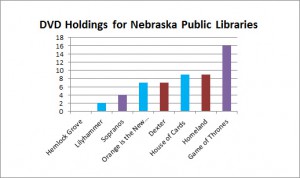 This week will be the beginning installment of Wednesday Watch. At first, the Dude was going to focus exclusively on what he’s currently watching, namely: (1) Lilyhammer (Netflix streaming); and (2) Boardwalk Empire (HBO via DVD from the local public library). And while the focus will be (yes, I did in fact start this sentence with And, and I did read Richard Miller’s Friday Reads post last week about the Grammar Lady—sorry, Richard, this is a low-brow column) on Lilyhammer, I decided to take a look at Nebraska public library holdings (at least those cataloged on WorldCat) of the top original series DVD’s from Netflix, HBO, and Showtime. The reason for this is that while streaming services are becoming more and more affordable, many (including the Dude) still simply cannot afford to buy subscriptions to premium content, including the newly available HBO Now. The chart includes the four Netflix original dramas (Hemlock Grove, Lilyhammer, Orange is the New Black, and House of Cards), and two of the most viewed drama series offerings from both HBO (Sopranos and Game of Thrones) and Showtime (Dexter and Homeland). But let’s first turn our attention to some filler material.
This week will be the beginning installment of Wednesday Watch. At first, the Dude was going to focus exclusively on what he’s currently watching, namely: (1) Lilyhammer (Netflix streaming); and (2) Boardwalk Empire (HBO via DVD from the local public library). And while the focus will be (yes, I did in fact start this sentence with And, and I did read Richard Miller’s Friday Reads post last week about the Grammar Lady—sorry, Richard, this is a low-brow column) on Lilyhammer, I decided to take a look at Nebraska public library holdings (at least those cataloged on WorldCat) of the top original series DVD’s from Netflix, HBO, and Showtime. The reason for this is that while streaming services are becoming more and more affordable, many (including the Dude) still simply cannot afford to buy subscriptions to premium content, including the newly available HBO Now. The chart includes the four Netflix original dramas (Hemlock Grove, Lilyhammer, Orange is the New Black, and House of Cards), and two of the most viewed drama series offerings from both HBO (Sopranos and Game of Thrones) and Showtime (Dexter and Homeland). But let’s first turn our attention to some filler material.
Lilyhammer, billed as a Netflix original drama series, is actually part drama part comedy (just like some of the others in the chart). The main character, underboss Frank “the Fixer” Tagliano (played by Steven Van Zandt –Silvio Dante from the Sopranos), flips on his mob boss and enters the witness protection program. As a part of the deal, he requests to relocate to Lillehammer, Norway. The show originally aired on Norwegian TV, even though it is generally known as the first Netflix original series. It’s probably more appropriate to label this as a joint venture between Norwegian TV and Netflix. Anyway, Frank adopts his new identity as Giovanni “Johnny” Henriksen (born to Italian and Norwegian parents). The show is as much about his integration into the Norwegian town and culture as it is about Johnny’s criminal ways. As Jimmy Darmody said in Boardwalk Empire: “You can’t be half a gangster.” The Dude would venture to say that in Lilyhammer (at least at the point where he is at in the series) Johnny has more relatable than detestable qualities, if that is possible for a gangster. The show is a mix of Norwegian and English languages, so expect many subtitles. While the typical comedic mafia elements exist, it doesn’t come across as completely recycled, and the Norwegian elements add a freshness that is, well, refreshing. The Dude finds himself nodding at times during Boardwalk Empire; he hasn’t had that problem with Lilyhammer. One thing to note, though, is that the budget for Lilyhammer (16 million per season) is obviously much less than say House of Cards (60 million per season), and that is apparent.
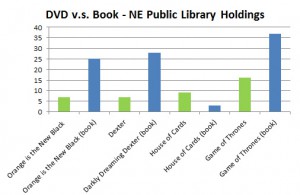 OK, so I extracted the holdings figures from Worldcat for the chart to at the top right. HBO’s Game of Thrones tops the list. Surprisingly, (at least to the Dude) House of Cards (tied with Homeland – another great offering from Showtime) beats HBO’s the Sopranos and Showtime’s Dexter for the number of holdings by Nebraska libraries. I also extracted the holdings information for the corresponding books (see the chart to the right of this paragraph). House of Cards is the only one where the DVD holdings exceed book holdings, with DVD holdings 3 times more than the book.
OK, so I extracted the holdings figures from Worldcat for the chart to at the top right. HBO’s Game of Thrones tops the list. Surprisingly, (at least to the Dude) House of Cards (tied with Homeland – another great offering from Showtime) beats HBO’s the Sopranos and Showtime’s Dexter for the number of holdings by Nebraska libraries. I also extracted the holdings information for the corresponding books (see the chart to the right of this paragraph). House of Cards is the only one where the DVD holdings exceed book holdings, with DVD holdings 3 times more than the book.
The Dude should mention that sans Hemlock Grove (he gets a little skittish with Horror) he’s seen and recommends all the series titles mentioned in the charts. He’s only read some of the Song of Ice and Fire (Game of Thrones) books (got bored about midway through A Feast for Crows), and frankly, does not have the desire to read on, or any of the other titles mentioned. And that’s OK. All in all, any of these DVD series titles would be a welcome addition to your library collection. Shaka.
Posted in Books & Reading, General, Library Management, Uncategorized
Leave a comment
The Data Dude – New Public Library Maps
 Shaka. Buried in the depths of the data services page of the NLC website is a section devoted to mapping. There are two new maps that were added to this section this week. Both are maps of Nebraska public libraries. The first is organized by service population, the second by library system. Similar maps have been on the website before, but these differ in that the information bubbles contain revised library photos, links to the library’s social media accounts (if those exist), and links to the library website. Please check your library marker and information bubble to make sure everything is up to date. There is a new section on the library supplemental survey called “Internet Services” where you can update any web links. Incidentally, it should be noted that whenever any of this information changes, you can update it from the supplemental survey at any time (it doesn’t necessarily have to be survey time). If you have any questions, comments, or suggestions about the maps, please let me know.
Shaka. Buried in the depths of the data services page of the NLC website is a section devoted to mapping. There are two new maps that were added to this section this week. Both are maps of Nebraska public libraries. The first is organized by service population, the second by library system. Similar maps have been on the website before, but these differ in that the information bubbles contain revised library photos, links to the library’s social media accounts (if those exist), and links to the library website. Please check your library marker and information bubble to make sure everything is up to date. There is a new section on the library supplemental survey called “Internet Services” where you can update any web links. Incidentally, it should be noted that whenever any of this information changes, you can update it from the supplemental survey at any time (it doesn’t necessarily have to be survey time). If you have any questions, comments, or suggestions about the maps, please let me know.
Friday Reads: Eat and Run by Scott Jurek
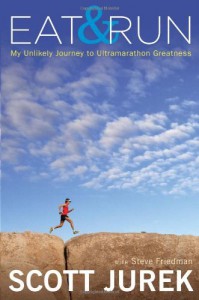 A few years back I discovered a documentary movie called Running on the Sun, about a brutal footrace called the Badwater 135 (that’s a 135 mile run through Death Valley, CA, in mid-July, often referred to as “the world’s toughest foot race”). If you have a chance, check it out. You can watch it all online, complete with German subtitles. It is a bit dated and there are other videos out there that might also be of interest (just do a search). Let’s just say up front that I never had any desire for these kinds of things, but after watching Running on the Sun, I became moderately interested in ultramarathon runners (defined as any running event that is longer than a marathon). My own running has waxed and waned over the years, settling on moderate amounts of mileage and hit and miss unstructured workouts. My interest in these ultra-events (sans particpation in them) extended to books and documentaries, including the self-promoting “Ultramarathon Man” Dean Karnazes. I don’t know if I’d describe him as outright arrogant or a just a peacock – the term given to guys who frequent running races or triathlons and strut around with their shirts off. I heard about another ultra guy named Scott Jurek when I read Christopher McDougall’s Born to Run, which seemed much less arrogant and peacock free.
A few years back I discovered a documentary movie called Running on the Sun, about a brutal footrace called the Badwater 135 (that’s a 135 mile run through Death Valley, CA, in mid-July, often referred to as “the world’s toughest foot race”). If you have a chance, check it out. You can watch it all online, complete with German subtitles. It is a bit dated and there are other videos out there that might also be of interest (just do a search). Let’s just say up front that I never had any desire for these kinds of things, but after watching Running on the Sun, I became moderately interested in ultramarathon runners (defined as any running event that is longer than a marathon). My own running has waxed and waned over the years, settling on moderate amounts of mileage and hit and miss unstructured workouts. My interest in these ultra-events (sans particpation in them) extended to books and documentaries, including the self-promoting “Ultramarathon Man” Dean Karnazes. I don’t know if I’d describe him as outright arrogant or a just a peacock – the term given to guys who frequent running races or triathlons and strut around with their shirts off. I heard about another ultra guy named Scott Jurek when I read Christopher McDougall’s Born to Run, which seemed much less arrogant and peacock free.
Jurek has written a book called Eat and Run. The appeal of Jurek is that he comes across as a down to earth modest guy, the antithesis of Karnazes. Jurek writes about his upbringing in Minnesota, candidly describing the care he gave to his mother during her suffering from multiple sclerosis. He also describes how he got started in the world of ultramarathon racing, and his climb to the near top, if not the top. The stories are entertaining, not just for the incredible racing feats, but because of the authenticity and humility that bleeds through in his writing. The other piece to Eat and Run is that Jurek only eats plant based foods, and some of his favorite vegan recipes are scattered throughout the book. Even if you are carnivorous and have no desire to change that fact, you might be motivated to try some of his recipes. I liked the Holy Moly Guacamole and Hemp Milk. Like many endurance athletes, Jurek has a great philosophy of life. A couple of notables:
“Every single one of us possesses the strength to attempt something he isn’t sure he can accomplish. It can be running a mile, or a 10K race, or 100 miles. It can be changing a career, losing 5 pounds, or telling someone you love her (or him).”
And:
“We all lose sometimes. We fail to get what we want. Friends and loved ones leave. We make a decision we regret. We try our hardest and come up short. It’s not the losing that defines us. It’s how we lose. It’s what we do afterward.”
The Data Dude – Public Library Survey Thank You
 The IMLS public library survey is now locked and Bibliostat will be compiling all the data from the submitted surveys. Thank you all for completing these. Our response rate was around 85%. Please send me any feedback on the survey, tweaks that can be made to next year’s report, or any suggestions about how the survey experience might be more pleasant. I also want to send an additional reminder to complete your supplemental survey if you haven’t done so already. Use your Bibliostat ID and password to access this. Actually, the supplemental survey it is more like a directory update, and it can be done at any time throughout the year. Please update it when your information changes (e.g. board members, staff members, phone numbers, etc.). This information is used to keep websites and directories up to date, and it won’t take you too much time to review this information. Shaka.
The IMLS public library survey is now locked and Bibliostat will be compiling all the data from the submitted surveys. Thank you all for completing these. Our response rate was around 85%. Please send me any feedback on the survey, tweaks that can be made to next year’s report, or any suggestions about how the survey experience might be more pleasant. I also want to send an additional reminder to complete your supplemental survey if you haven’t done so already. Use your Bibliostat ID and password to access this. Actually, the supplemental survey it is more like a directory update, and it can be done at any time throughout the year. Please update it when your information changes (e.g. board members, staff members, phone numbers, etc.). This information is used to keep websites and directories up to date, and it won’t take you too much time to review this information. Shaka.
The Data Dude – Wednesday Watch
 In order to keep up with the demands of writing something for every Wednesday, the Dude has been brainstorming ideas for filler material. Unlike Lori Sailors (Throwback Thursday), the Dude doesn’t have drawer after drawer full of interesting stuff to post. It’s quite possible that simple or complex graphs and charts… ahem, I mean data displays, could be regurgitated each week. But let’s face it; doing so would be at least unnecessarily repetitive and at best moderately boring. That’s not to say there won’t be blog posts on data displays, but the Dude needs something somewhat relevant to draw from in the case he suffers from lack of inspiration. Welcome to the Wednesday Watch. The idea here is that the Commission has somewhat regular sorts of columns, such as Throwback Thursday, Friday Reads, What’s Sally Reading, and others. Aside from Throwback Thursday, the others focus on books in library collections. Wednesday Watch will focus on video. As some may ask: What’s Sally Reading? I’ll ask: What’s the Dude Watching? The Wednesday Watch column will likely be similar to Friday Reads, except the Dude ain’t reading it, he’s watching it. In some (but not all) cases, it’s possible he may read it and watch it. And the Dude isn’t going to apologize for the fact that he might not have read or even wanted to read it (or for the fact that he started a sentence with the word And). Please e-mail me if you’re interested in being a guest columnist in this buffoonery. The Dude could use the help.
In order to keep up with the demands of writing something for every Wednesday, the Dude has been brainstorming ideas for filler material. Unlike Lori Sailors (Throwback Thursday), the Dude doesn’t have drawer after drawer full of interesting stuff to post. It’s quite possible that simple or complex graphs and charts… ahem, I mean data displays, could be regurgitated each week. But let’s face it; doing so would be at least unnecessarily repetitive and at best moderately boring. That’s not to say there won’t be blog posts on data displays, but the Dude needs something somewhat relevant to draw from in the case he suffers from lack of inspiration. Welcome to the Wednesday Watch. The idea here is that the Commission has somewhat regular sorts of columns, such as Throwback Thursday, Friday Reads, What’s Sally Reading, and others. Aside from Throwback Thursday, the others focus on books in library collections. Wednesday Watch will focus on video. As some may ask: What’s Sally Reading? I’ll ask: What’s the Dude Watching? The Wednesday Watch column will likely be similar to Friday Reads, except the Dude ain’t reading it, he’s watching it. In some (but not all) cases, it’s possible he may read it and watch it. And the Dude isn’t going to apologize for the fact that he might not have read or even wanted to read it (or for the fact that he started a sentence with the word And). Please e-mail me if you’re interested in being a guest columnist in this buffoonery. The Dude could use the help.
Perhaps some of these things can be used in your collection development, or turn you or the visitors to your library on to something new. Now, before the librarian in you gets a little figety, let me clarify, the Dude still likes to read, and while he may choose not to read some evenings in favor of a video banquet, there’s certainly nothing wrong with that. So, let’s start this Wednesday Watch by listing a few movies that are generally known to be better than the books. Or, let me clarify, perhaps some of these were better than the books, perhaps others weren’t necessarily better, but they at least did the books justice. It is, however, a matter of taste, and let’s acknowledge that.
So for today, let’s just say that in some instances, the book may not always better than the movie (rule #1: There are no universals in our world). And let’s also say that sometimes the movie or TV series is in higher demand than the printed material. Deep down you know that it’s true, but for some reason the librarian gene (or the librarian learned pretentiousness in you) says it’s wrong to think so. The Dude is telling you its ok, or at least it’s ok with the Dude. On to the list:
The Godfather
Psycho
Blade Runner
Die Hard (have you ever even heard of the book? ‘Nuff said)
Jaws
Apocalypse Now
Shawshank Redemption
Requiem for a Dream
Silence of the Lambs
Stand by Me
Goodfellas
Shaka.
Posted in General, Library Management, Uncategorized
1 Comment
The Data Dude on Data Visualizations
 The Nebraska Library Association’s Advocacy Day was yesterday. The purpose of this post today is to give you a link to the handouts that were provided for the event, including summaries of the NLC’s new budget request items. Of course, the purpose is also to reiterate the importance of gathering statistical data from surveys and how the collected data might be used. The survey data that Nebraska public libraries provide (e.g. the IMLS public library survey, digital inclusion survey, etc.) make these handouts possible. Another invaluable contributor to the handouts includes public librarians and library visitors, who provided testimonials and photo images. I won’t list all of you that contributed, but you know who you are. Even if you provided something that didn’t ultimately make it into the handout, thank you for your time and efforts. Special thanks go out to Pete and Jaden Ferguson, and the Foundation for the Lincoln City libraries. Pete and Jaden’s flyer from the LCL Foundation’s Idea Place campaign provided the theme for the general handout, and for that reason I would like to express my gratitude and thanks.
The Nebraska Library Association’s Advocacy Day was yesterday. The purpose of this post today is to give you a link to the handouts that were provided for the event, including summaries of the NLC’s new budget request items. Of course, the purpose is also to reiterate the importance of gathering statistical data from surveys and how the collected data might be used. The survey data that Nebraska public libraries provide (e.g. the IMLS public library survey, digital inclusion survey, etc.) make these handouts possible. Another invaluable contributor to the handouts includes public librarians and library visitors, who provided testimonials and photo images. I won’t list all of you that contributed, but you know who you are. Even if you provided something that didn’t ultimately make it into the handout, thank you for your time and efforts. Special thanks go out to Pete and Jaden Ferguson, and the Foundation for the Lincoln City libraries. Pete and Jaden’s flyer from the LCL Foundation’s Idea Place campaign provided the theme for the general handout, and for that reason I would like to express my gratitude and thanks.
If you didn’t attend Advocacy Day, you can see the handouts online. They might be helpful by giving you more information about the current budget requests, as well as some of the statistics and data about Nebraska public libraries. Hopefully, it will also provide some degree of validation for all the work to gather and report public library statistics, especially for those of you that have just completed your public library surveys. Shaka.
The Data Dude on Other Materials
 This week, the Dude looked at a part of the public library survey that is often forgotten, element number 4.33, Description of Other Materials. In Nebraska, the leader in this category is cake pans (74), followed by puzzles (33), and discovery packs (9). Others include some fairly obvious choices such as framed art, sculpture, watt meters, toys, puppets, eReaders, games, gaming equipment, and quilt patterns. Some not so obvious choices (but good ideas) include grief kits (Bellevue Public Library), compasses (Lied Randolph Public Library), CD/DVD cleaners (Sidney Public Library), umbrellas and Frisbees (South Sioux City Public Library), overhead projector (Verdigre Public Library), and a Moon Kit (Yutan Public Library). It’s important to note that the other item holdings often differ based on the unique needs of the local communities. Another other material that is worth mentioning is the seed exchange (although the Crete Public Library is the only public library to report this on their survey, there certainly are more Nebraska libraries doing this). While seed exchanges are, technically illegal (but generally unenforced) due to antiquated legislation, there is a current bill in the Nebraska Legislature to legitimize seed exchanges by adopting the Community Gardens Act. But while part of the focus of this post is to applaud these other materials offerings, it also is to point out what is missing from it.
This week, the Dude looked at a part of the public library survey that is often forgotten, element number 4.33, Description of Other Materials. In Nebraska, the leader in this category is cake pans (74), followed by puzzles (33), and discovery packs (9). Others include some fairly obvious choices such as framed art, sculpture, watt meters, toys, puppets, eReaders, games, gaming equipment, and quilt patterns. Some not so obvious choices (but good ideas) include grief kits (Bellevue Public Library), compasses (Lied Randolph Public Library), CD/DVD cleaners (Sidney Public Library), umbrellas and Frisbees (South Sioux City Public Library), overhead projector (Verdigre Public Library), and a Moon Kit (Yutan Public Library). It’s important to note that the other item holdings often differ based on the unique needs of the local communities. Another other material that is worth mentioning is the seed exchange (although the Crete Public Library is the only public library to report this on their survey, there certainly are more Nebraska libraries doing this). While seed exchanges are, technically illegal (but generally unenforced) due to antiquated legislation, there is a current bill in the Nebraska Legislature to legitimize seed exchanges by adopting the Community Gardens Act. But while part of the focus of this post is to applaud these other materials offerings, it also is to point out what is missing from it.
So what is noticeably absent? Tools. Not one Nebraska public library reported having tools of any sort. Why is there more of an emphasis on baking a cake than a bathroom remodel? You say cake pan, I say wet saw, lawn aerator, or sawzall. Is it a liability issue? Perhaps. Maintenance issue? Sure, it could be. Expense? Likely, yes. Gender? I dunno. Could it simply be that tools are loaned person to person, and a library isn’t necessary? Possibly. There isn’t a local outcry for tool offerings? Maybe not, but is there a local outcry for cake pans? Conceivably, there could be more investment in a comprehensive tool library and time consumption for maintenance. Now that the Dude has exhausted all synonyms for the word maybe, what about basic or specialty tools that probably aren’t real expensive? What about donated tools? You see, the Dude recently is in the process of working on cleaning a clogged bathtub drain and in the process of the strainer extraction, he broke the screw holding the drain together. Guess what he now needs? A special extraction tool. The Dude will most likely purchase this tool (it’s still cheaper than calling a plumber), and probably only use it once (if it is needed at some point down the road undoubtedly it will become lost in sea of other garage residents or forgotten altogether). This is the kind of thing that would be an ideal choice for donation to a tool library.
But the point of all this is not to say rush out and get sets of tools (or Frisbees, or moon kits, or framed art), but to say what does your community value? How can you achieve the goals of providing things that are important to them? How do you know? What about bringing local community talents together for programs, then evaluating interest?
Finally, the Sacramento Public Library is worth noting, as they have jumped into the deep end of this sort of thing, implementing a Library of Things project. The idea is that many residents of their community don’t have the money or storage space for things they don’t often use but occasionally need. The Sacramento Public Library funded its Library of Things from a $10,000 LSTA grant. They set up a separate webpage to collect votes for “arts and innovation” items requested to be made available. You might get ideas from the top vote getters, which were card or board games for children and adults (196 votes); craft tools such as sewing machines and others (183 votes); musical instruments (178 votes); Go Pro cameras (177 votes); camping kits (160 votes); artifacts for the classroom/school students such as WW II memorabilia and other things that illustrate life in earlier times (143 votes); and a binding machine for creating your own books, journals, etc. (134 votes). Some of the Dude’s favorites, but not necessarily top vote getters include garden tools (e.g. loppers, rototillers, etc.), old school/nostalgic video game systems (think Atari, Nintendo, etc.), button makers (hey, the Dude has an upholstery button maker he hasn’t used in about 12 years. Perfect!), food dehydrators, Karaoke machines, carpet steam cleaners, telescopes, basic wood tools, ladders, bread machines, unicycles, bike tool kits, paint sprayers, Kreg Jigs, a drone with HD camera, chain saws, and soldering irons. The Dude would add croquet sets/bocce balls and surfboards or stand up paddleboards to the list. The boards are worth noting because they still are on the Dude’s to-do list for making as soon as the garage gets cleaned out. The Dude is still deciding whether or not to try a hollow SUP type board or a more classical Alaia (Tom Wegner is the master of this craft). The other advantage to having these sorts of things in a library is that they can be found, unlike many things that reside in the Dude’s garage, but are impossible to locate when needed. Shaka.
The Data Dude on Motion Charts
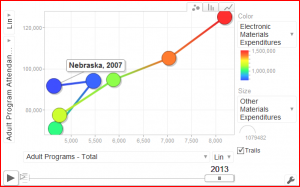 Shaka. Today, the Dude will focus on Google motion charts. This may be a complex or simple matter (depending on your perspective and degree of tech-savviness). It also may depend on your interest in data displays, which might currently be in the toilet after looking at all the survey data you have been reporting. This won’t stop the Dude from making a feeble attempt to show how the data you collect and report might be valuable to illustrate library trends, and that may rescue those that hold to the belief that there is excessive frivolity in the survey reporting.
Shaka. Today, the Dude will focus on Google motion charts. This may be a complex or simple matter (depending on your perspective and degree of tech-savviness). It also may depend on your interest in data displays, which might currently be in the toilet after looking at all the survey data you have been reporting. This won’t stop the Dude from making a feeble attempt to show how the data you collect and report might be valuable to illustrate library trends, and that may rescue those that hold to the belief that there is excessive frivolity in the survey reporting.
First, some background information (or filler material). The Dude was introduced to the motion chart (aka interactive bubble chart) by Hans Rosling’s TED talk. Watch it and you will be entertained. The software for the bubble (or motion) chart was created by Rosling’s Gapminder Foundation. In 2007, the motion chart was acquired by Google, and now anyone can create these interactive charts with a free Google account. The Dude will skip the steps on how to get the data into the chart (that will be saved for another day), but basically you load a spreadsheet and tweak the columns a bit.
The chart above is a static version from a motion chart the Dude created with the data from the Nebraska public library surveys from 2007 to 2013. It encompasses all the reported data for libraries in the state. The bubble (in this case there is only one, but you can add many more if you create your own chart) represents the size of the entity (typically population, and in this case the total legal service population of Nebraska libraries). There are two axes and the data for either one can be changed by clicking on the little arrow next to the description. There is a slider at the bottom that has a play button to set everything in motion by time. When you do this, the bubble moves either up or down depending on the changes in the data on the vertical axis. Simultaneously, the bubble moves either left or right, depending on changes in the data on the horizontal axis. In this example, the Dude compared the number of adult programs to adult program attendance (if you load the actual motion chart from the link above, you will have to select this from the menu bars on the left and the bottom). As you can see from the static image, programs went up with attendance remaining mostly the same from 2007 to 2008, then there was a decrease in programs and attendance from 2008 to 2009, and then a nice, consistent increase in both from 2010-2013.
As with anything else, sometimes the motion chart might not always be the best choice for your data visualization. Andrew Abela has created this nifty chart chooser to help you decide what visualization you might want to use, depending on what trend you might like to show. The Dude is working on more motion charts, with more bubbles, perhaps to take the public library survey data and illustrate all the libraries and their data together, or perhaps just a particular library and its peers. Any feedback on this project would be nice to have, and if any of you need assistance with motion charts, feel free to let me know.
The Data Dude – Game of Thrones Data Visualization
 Well, this week’s post almost didn’t happen because the Dude has been swamped with surveys, Monday was President’s Day, and the Dude is home today with a sick kid. As an update to the public library survey (the deadline was last Friday the 13th), thank you e-mails have been sent out to those of you who have submitted and finalized your surveys. There are some surveys that have issues that are in need of a little TLC, and you should have received e-mail questions or calls about those by now. If all your issues are cleared up (or if you had no issues to begin with) you should have received an e-mail about the supplemental survey. If you haven’t, please let me know and I will check on the status of your survey. Since the Dude is still working on finalizing some surveys, wait a few weeks for the final numbers on our survey response rates.
Well, this week’s post almost didn’t happen because the Dude has been swamped with surveys, Monday was President’s Day, and the Dude is home today with a sick kid. As an update to the public library survey (the deadline was last Friday the 13th), thank you e-mails have been sent out to those of you who have submitted and finalized your surveys. There are some surveys that have issues that are in need of a little TLC, and you should have received e-mail questions or calls about those by now. If all your issues are cleared up (or if you had no issues to begin with) you should have received an e-mail about the supplemental survey. If you haven’t, please let me know and I will check on the status of your survey. Since the Dude is still working on finalizing some surveys, wait a few weeks for the final numbers on our survey response rates.
With the Dude suffering from a bit of a survey hangover, there is a shortage of material for this week’s post. Now, some of the abstract ideas ranged from word clouds, stories about robots in libraries, and more statistics on technology. But let’s be honest; the Dude finds most word clouds to be a bore, so they will be saved for another day when boring is on the menu. So for today the Dude will keep it simple, and note his interest in Reddit’s DataisBeautiful, mostly because the data there is usually interesting but also because it is often uniquely presented. Using data in a simple way such as this not only gets a point across, but fits the innovative bill as well. Enter this image, illustrating the number of deaths in George RR Martin’s Song of Fire and Ice series. For GOT fans, the image says it all. For the record, the Dude is a fan of the HBO series (since the Dude doesn’t have cable, he wishes to thank Lincoln City Libraries for selecting the DVD’s in their collection), but found the books (after about the first 1/3 of Storm of Swords) to be long-winded. The Dude ain’t afraid to say it. Shaka.
The Data Dude – Technology Tidbit
 The Dude has been busy reviewing all your public library surveys and trying his best to answer your questions about what to report where (sometimes it’s a judgment call), but took a bit of time to throw together this little technology tidbit. Keep the surveys coming, as the response rate is roughly 50% at the moment, and the deadline is Friday the 13th of February. One more item of note before heading to the stats, and that is, please let me know about any suggestions for next year’s survey (and keep in mind that getting rid of it altogether is not an option). Some of you have already sent suggestions, and I have ideas of my own, but I’d certainly like to hear your thoughts.
The Dude has been busy reviewing all your public library surveys and trying his best to answer your questions about what to report where (sometimes it’s a judgment call), but took a bit of time to throw together this little technology tidbit. Keep the surveys coming, as the response rate is roughly 50% at the moment, and the deadline is Friday the 13th of February. One more item of note before heading to the stats, and that is, please let me know about any suggestions for next year’s survey (and keep in mind that getting rid of it altogether is not an option). Some of you have already sent suggestions, and I have ideas of my own, but I’d certainly like to hear your thoughts.
According to the U.S. Census Bureau, More than 21% of Nebraskans do not have access to high speed internet (a paid internet service other than dial-up) at home. This is close to the national average (about 22%), and thus underlies the importance of public offerings for technology services (such as libraries). The leader is New Hampshire, with almost 86% of its residents living in a household with high speed internet, and just over 93% in a household with a computer. These numbers do not address the FCC’s recent redefinition of what constitutes “broadband” (and by implication “high speed”), as the FCC now labels broadband as anything more than 25 Mbps.
According to the 2013 public library survey (last year’s survey), Nebraska libraries provide:
- Free public internet access (99% of libraries with 2.2 Million annual uses)
- Free WiFi (94% of libraries)
Even if, or rather, when, improvements are made to services and pricing so that high speed or broadband becomes more prevalent in more households (and hopefully the FCC’s redefinition expedites that), there will still be the need to address the digital literacy of the users. Just because I got the new dual motor, AWD, 691 hp, 3.2 seconds to 60 mph, all electric, zero emissions Tesla Model S P85D doesn’t mean I know how to drive it well. The Dude would have the patience to try and learn, however, if given the opportunity. OK, perhaps comparing the Tesla Model S P85D to 25 Mbps broadband isn’t an apt analogy, but the point is that even with increased speed and access, there will be a need for assistance navigating the waters, and that’s where libraries and librarians have the opportunity to excel. To further illustrate, last year’s Digital Inclusion Survey noted that Nebraska libraries also provided:
- Online employment resources (98% of libraries)
- Computer training (97% of libraries)
- Assistance with completing government forms online (98% of libraries)
Shaka.
The Data Dude – Public Library Survey
 Shaka. It is getting close to crunch time for the annual IMLS Public Library Survey. The deadline is February 13, 2015, a mere 9 days away. The Bibliostat Collect portion of the data services section of the NLC website has a link to the login, instructions, tips, and other tidbits to help you complete the survey. Keep in mind that the survey is required for your library to receive state aid if you are accredited. If you aren’t accredited, you still have an incentive to complete the survey ($200), called Dollar$ for Data.
Shaka. It is getting close to crunch time for the annual IMLS Public Library Survey. The deadline is February 13, 2015, a mere 9 days away. The Bibliostat Collect portion of the data services section of the NLC website has a link to the login, instructions, tips, and other tidbits to help you complete the survey. Keep in mind that the survey is required for your library to receive state aid if you are accredited. If you aren’t accredited, you still have an incentive to complete the survey ($200), called Dollar$ for Data.
As of this morning, around 33% of Nebraska public libraries have completed the survey. I know some of you are waiting for figures from governmental entities or perhaps are just procrastinators. Please don’t wait until the last minute, just in case you might have problems or if issues arise.
I am here to help you with the process in any way I can. Don’t hesitate to contact me. Thank you in advance for your participation and patience.

